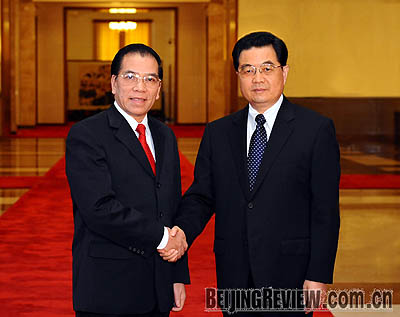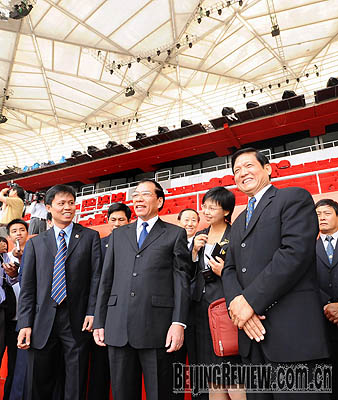|

STRONGER TIES: General Secretary of the Communist Party of China Hu Jintao welcomes General Secretary of the Communist Party of Viet Nam Nong Duc Manh at the Great Hall of the People in Beijing on May 30
Four phrases describe China's current relationship with Viet Nam: good neighbors, good friends, good comrades and good partners. These four traits also reflect the spirit of their bilateral ties.
During General Secretary of the Communist Party of Viet Nam (CPV) Nong Duc Manh's recent four-day visit to China, the two countries issued a joint statement, upgrading their relationship to an all-round strategic cooperative partnership-a milestone in the progress of their bilateral ties.
Nong Duc Manh exchanged views with Chinese leaders on various topics, especially trade and economic cooperation. According to the statement, the two sides decided to complete their borderline survey and sign a related management paper by the end of 2008. They also decided to develop high-level exchanges, open a hotline between their state leaders and improve their communication in other fields. The joint statement pointed out the direction of a deepening bilateral relationship in a new era, said General Secretary of the Communist Party of China (CPC) and Chinese President Hu Jintao.
"The joint statement symbolizes an overall promotion of the bilateral political and economic relationship," said He Sheng, an expert on Viet Nam studies at the China Institutes of Contemporary International Relations (CICIR).
Satisfaction guaranteed
In 1999, the leaders of both nations confirmed the guiding principles of "long-term stability, orientation toward the future, good-neighborliness and friendship, and all- round cooperation" between them. At the beginning of this century, the leaders of the two countries are of a new generation, but their common target of strengthening the bilateral relationship has not changed. In late October 2005, Hu visited Viet Nam and met Nong Duc Manh. They defined the above-mentioned "Four Goods" as the spirit of their bilateral ties.
He Sheng from the CICIR pointed out that by issuing the recent joint statement, Chinese and Vietnamese state leaders have mapped out the future of the bilateral relationship and targeted its strategic direction. He noted the four highlights of Nong Duc Manh's visit.
First, the two sides stressed communication between the CPC and the CPV. Both China and Viet Nam are socialist countries under Communist Party leadership.
"They have the same ideals, same roads and similar situations in their countries," He said. "Currently, they have the same mission-to transfer to a market economy from a planned economy." The two parties can learn from each other's experiences and avoid detours when constructing socialism. Furthermore, increased communication between the parties also is greatly promoting their bilateral relationship, He said.

IN THE NEST: General Secretary of the Communist Party of Viet Nam Nong Duc Manh (center) visits the National Stadium, or the Bird’s Nest, in Beijing on May 31
The second highlight is that the two sides decided to set up a hotline between their state leaders and strengthen communication between high-level officials. The move could reflect a closer political relationship between China and Viet Nam, He said.
Third, the two sides stressed that they planned to complete their borderline survey and sign a management paper this year. The two countries have already finished 80 percent-90 percent of the total surveying work, in accordance with principles in an agreement they signed in 1999. They officially started to plant land markers delineating their 1,350-km frontier in 2002.
"The complicated geographic situation in the boundary area is the biggest problem," He said. Once the entire borderline has been mapped out, this borderline would become "a bond of friendship" that will help the countries maintain stability in their bilateral boundary areas, He said. The settlement of border issue also would promote cross-border trade and improve the transportation situation to further develop the area.
Both China and Viet Nam are paying more attention to improving infrastructure construction in their border areas. Just before Nong Duc Manh's visit to China, the two sides decided to enlarge nine cross-border transportation routes. They also are working on simplifying the procedures for Customs declarations to promote cross-border trade.
The fourth highlight is that the two sides confirmed their common goal of maintaining stability in the South China Sea and advancing related negotiations. "Both realize that any complication of the issue never is a wise choice," He said.
The two sides were satisfied with the agreements made during Nong Duc Manh's visit. When meeting with Nong Duc Manh on May 31, Chinese Premier Wen Jiabao said that under their new partnership, China and Viet Nam would reinforce their mutual political trust, cooperate more in various fields and deepen the friendship between their peoples. The joint statement "charts a new path for future Sino-Vietnamese ties," Wen said.
Zhai Kun, Director of Southeast Asian and the Oceanian Studies of the CICIR, published an article about Nong Duc Manh's visit in People's Daily, pointing out that there were three tasks the two sides should work together on-advancing their socialist societies, properly dealing with and settling issues in their bilateral relations, and making efforts to build lasting peace and common prosperity in Asia and the rest of the world.
Doing business
Trade and economic cooperation between China and Viet Nam has progressed rapidly in recent years.
China has become Viet Nam's top trade partner. Their bilateral trade volume reached $15 billion in 2007, the target amount that the two sides planned for 2010. Since they had met their goal three years earlier than scheduled, China and Viet Nam now are outlining their economic and trade collaboration for the next several years. And the two countries are speeding up the creation and implementation of a five-year economic and trade cooperation program.
"We are convinced that it will not be difficult for our trade to reach $20 billion per year in the near future," Nong Duc Manh said after meeting with Wen. In turn, Wen suggested the two countries quickly launch big projects in key industries, including infrastructure and energy, and encouraged Chinese businesspeople to invest more in Viet Nam.
He Sheng from the CICIR said China and Viet Nam have been working in recent years on a "Two Corridors and One Ring" project. These refer to the Kunming-Laojie-Hanoi-Hai Phong-Quang Ninh and the Nanning-Liangshan-Hanoi-Hai Phong-Quang Ninh economic corridors and the Beibu Bay economic rim. Most of these cities are located along the two countries' borderline. Under the project, China and Viet Nam are focusing on increasing their trade and economic cooperation by implementing more reciprocal policies on trade and investment. He said the project, as a sub-regional cooperation framework, also would help to advance the construction of the China-ASEAN free trade zone.
According to the joint statement, the two sides agreed to open new trade growth points, while adopting effective measures to improve trade structures to realize balanced development in bilateral trade for win-win results.
Moreover, the two countries are actively implementing the Beibu Bay Demarcation Agreement and the Agreement on Fishery Cooperation in the Beibu Bay, so as to strive to achieve substantial results in cross-border surveys and the exploration of oil and natural gas deposits.
"Now the trade structure between China and Viet Nam is not quite balanced, and if we do not solve the problem properly, it may be a bottleneck for bilateral trade and economic cooperation," He said.
Statistics show that iron and steel, electric machines, fuel and fertilizer exported to Viet Nam accounted for almost 57 percent of China's total export volume in 2007. Viet Nam exported mainly energy-condensed products to China, such as crude oil, mineral products, natural rubber and charcoal, which accounted for 52 percent of its total export volume to China in 2007.
Some international organizations have been concerned about Viet Nam's recent financial problems, mainly triggered by inflation. Some economists have warned that once Viet Nam enters a full-blown financial crisis, China could be drawn into it. But Chinese experts said that the current financial problems in Viet Nam would not influence trade and economic cooperation between the two countries.
He Fan from the Chinese Academy of Social Sciences said that Asian countries have not been much influenced by Viet Nam's liquidity crisis. Other countries, including China, should help Viet Nam get over its economic troubles, he added. | 